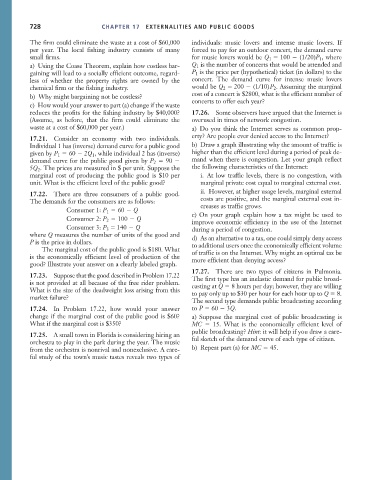Page 754 - Microeconomics, Fourth Edition
P. 754
c17ExternalitiesandPublicGoods.qxd 8/22/10 4:56 AM Page 728
728 CHAPTER 17 EXTERNALITIES AND PUBLIC GOODS
The firm could eliminate the waste at a cost of $60,000 individuals: music lovers and intense music lovers. If
per year. The local fishing industry consists of many forced to pay for an outdoor concert, the demand curve
small firms. for music lovers would be Q 1 100 (1/20)P 1 , where
a) Using the Coase Theorem, explain how costless bar- Q 1 is the number of concerts that would be attended and
gaining will lead to a socially efficient outcome, regard- P 1 is the price per (hypothetical) ticket (in dollars) to the
less of whether the property rights are owned by the concert. The demand curve for intense music lovers
chemical firm or the fishing industry. would be Q 2 200 (1/10)P 2 . Assuming the marginal
b) Why might bargaining not be costless? cost of a concert is $2800, what is the efficient number of
c) How would your answer to part (a) change if the waste concerts to offer each year?
reduces the profits for the fishing industry by $40,000? 17.26. Some observers have argued that the Internet is
(Assume, as before, that the firm could eliminate the overused in times of network congestion.
waste at a cost of $60,000 per year.) a) Do you think the Internet serves as common prop-
17.21. Consider an economy with two individuals. erty? Are people ever denied access to the Internet?
Individual 1 has (inverse) demand curve for a public good b) Draw a graph illustrating why the amount of traffic is
given by P 1 60 2Q 1 , while individual 2 has (inverse) higher than the efficient level during a period of peak de-
demand curve for the public good given by P 2 90 mand when there is congestion. Let your graph reflect
5Q 2 . The prices are measured in $ per unit. Suppose the the following characteristics of the Internet:
marginal cost of producing the public good is $10 per i. At low traffic levels, there is no congestion, with
unit. What is the efficient level of the public good? marginal private cost equal to marginal external cost.
17.22. There are three consumers of a public good. ii. However, at higher usage levels, marginal external
The demands for the consumers are as follows: costs are positive, and the marginal external cost in-
creases as traffic grows.
Consumer 1: P 1 60 Q
c) On your graph explain how a tax might be used to
Consumer 2: P 2 100 Q
improve economic efficiency in the use of the Internet
Consumer 3: P 3 140 Q during a period of congestion.
where Q measures the number of units of the good and d) As an alternative to a tax, one could simply deny access
P is the price in dollars. to additional users once the economically efficient volume
The marginal cost of the public good is $180. What of traffic is on the Internet. Why might an optimal tax be
is the economically efficient level of production of the more efficient than denying access?
good? Illustrate your answer on a clearly labeled graph.
17.27. There are two types of citizens in Pulmonia.
17.23. Suppose that the good described in Problem 17.22 The first type has an inelastic demand for public broad-
is not provided at all because of the free rider problem. casting at Q 8 hours per day; however, they are willing
What is the size of the deadweight loss arising from this to pay only up to $30 per hour for each hour up to Q 8.
market failure?
The second type demands public broadcasting according
17.24. In Problem 17.22, how would your answer to P 60 3Q.
change if the marginal cost of the public good is $60? a) Suppose the marginal cost of public broadcasting is
What if the marginal cost is $350? MC 15. What is the economically efficient level of
public broadcasting? Hint: it will help if you draw a care-
17.25. A small town in Florida is considering hiring an
orchestra to play in the park during the year. The music ful sketch of the demand curve of each type of citizen.
from the orchestra is nonrival and nonexclusive. A care- b) Repeat part (a) for MC 45.
ful study of the town’s music tastes reveals two types of

